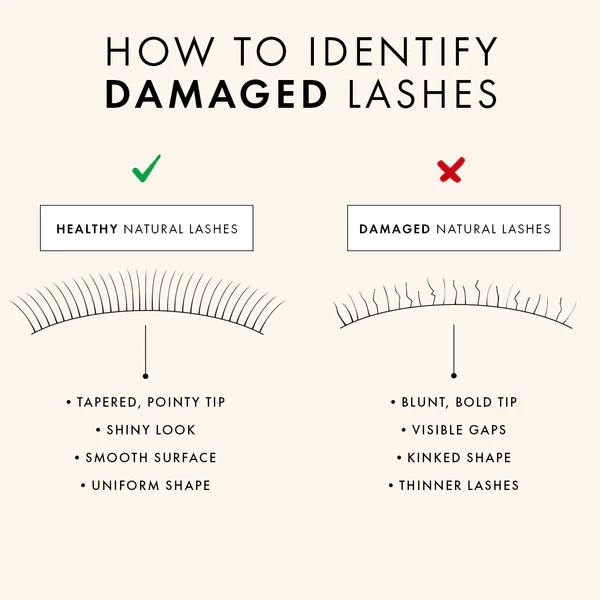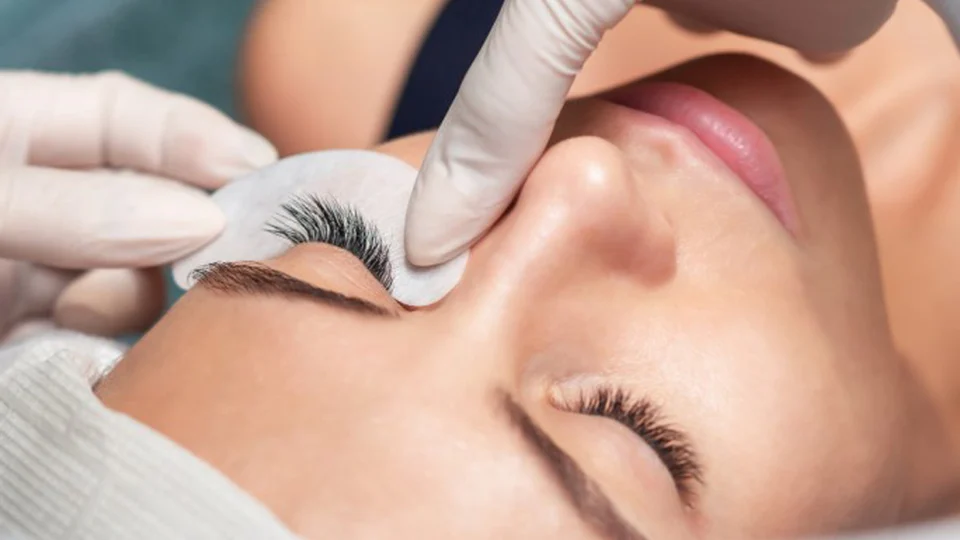How to Fix Lashes After Lash Lift?
🚨 MEDICAL DISCLAIMER
This article compiles guidance from verified medical sources and licensed professionals. This information is for educational purposes only and does not constitute medical advice.\
Always consult with a licensed esthetician, dermatologist, or eye care professional for personalized treatment of eye-area concerns.
If you experience severe irritation, chemical burns, or persistent problems after a lash lift, seek professional medical attention immediately.
What to Do When Lash Lift Goes Wrong
If your lash lift results are damaged, frizzy, or over-curled, the appropriate response depends on severity. For minor problems, gentle care with moisturizing treatments and avoiding water for 24-48 hours may help, combined with careful brushing using a clean spoolie.
For severe damage including signs of chemical burns, excessive irritation, or broken lashes, consult a licensed professional promptly.
Most lash lift complications resolve naturally through the lash growth cycle (6-8 weeks), but professional assessment is essential for serious issues. Never attempt DIY chemical treatments as these can worsen damage.
When to Seek Professional Care
Signs Requiring Professional Consultation
According to Cleveland Clinic medical experts, lash lifts can cause allergic reactions and inflammation around the eye area, making professional consultation important when problems occur. Consider professional care if you experience:

Chemical irritation signs:
- Skin irritation, itching, burning, rash, blisters
- Inflammation and/or redness around the eye area
- Persistent discomfort lasting beyond 48-72 hours
Severe lash damage:
- Brittle, breaking, or significantly damaged lashes
- Excessive lash loss or thinning
- Visible chemical damage to lash structure
Eye area concerns:
- Any discomfort affecting the eye itself
- Vision changes or eye pain
- Swelling that doesn't subside within 24-48 hours
Professional vs. Home Care Guidelines
Professional Consultation Recommended When:
- Lashes show signs of over-processing with breakage, stunted growth, or loss
- Skin shows signs of allergic reaction or chemical sensitivity
- Previous lash lift was performed by unlicensed technician
- You have history of eye sensitivities or allergies
- Symptoms persist or worsen after 48-72 hours
Safe for Gentle Home Support When:
- Minor styling issues without damage
- Lashes feel dry but remain intact
- No skin irritation or eye discomfort
- Issues are purely cosmetic rather than health-related
Professional Treatment Options
Licensed Professional Approaches
Professional correction of lash lift problems involves specialized assessment and may include:
Available Professional Services:
- Damage Assessment - Professional evaluation of lash health and chemical effects
- Corrective Conditioning - Professional-grade conditioning treatments
- Gentle Restoration - Gradual approaches allowing natural lash recovery
For severe over-processing, professionals may recommend safely reversing the perm effect using specialized neutralizing solutions.
Important Professional Considerations
Cleveland Eye Clinic recommends seeking care with an optometrist or ophthalmologist (not urgent care) if problems occur after lash lift treatments. This ensures proper evaluation of any eye-area concerns.
Professional Standards Include:
- Proper assessment before any corrective treatment
- Use of professional-grade, safer products
- Understanding of contraindications and risk factors
- Appropriate referral to medical professionals when needed
Safe Home Support Methods
How to Fix Frizzy Lashes After Lash Lift
Frizzy lashes after a lash lift typically indicate overprocessing with chemicals. Safe home support focuses on gentle care rather than attempting correction:
Gentle Care Approach:
- Moisturizing treatments - Apply small amounts of conditioning products to lash tips (avoiding root area) to help prevent further breakage. Note: While products like castor oil are commonly recommended, there is no scientific evidence they promote lash growth. They may help moisturize lashes and make them appear fuller through coating, but cannot repair chemical damage.
- Commercial lash serums - Use products specifically designed for lash health (proper application guidance here). Look for ingredients like peptides and vitamins that support overall lash condition.
- Gentle handling - Brush carefully with clean spoolie, avoiding aggressive manipulation that could cause additional breakage.
- Patient approach - Allow natural lash cycle (6-8 weeks) to gradually replace damaged lashes. This is the most effective "repair" method.
Important Note About Natural Oils: Multiple dermatology experts confirm that castor oil, coconut oil, and similar natural oils have NOT been proven to stimulate eyelash growth in scientific studies.
While they may moisturize lashes and provide a coating that makes them appear thicker, they cannot reverse chemical damage or accelerate growth. Their primary benefit is helping prevent additional breakage by keeping lashes moisturized.
Daily Care During Recovery
Recommended Practices:
- Follow post-lift care guidelines: avoid water and steam for 24-48 hours
- Refrain from rubbing or touching lashes
- Use gentle, oil-free makeup removal methods
- Apply any conditioning treatments sparingly to avoid weighing down lashes
- Sleep carefully to avoid crushing or bending recovering lashes
Practices to Avoid:
- Using waterproof mascara during recovery period
- Mechanical lash curling which could worsen damage
- Any DIY chemical treatments or "correction" products
- Excessive manipulation or pulling on damaged lashes
How to Fix Bent Eyelashes After Lash Lift
Understanding Over-Curling Issues
Professional analysis identifies that over-curled or bent lashes typically result from:
- Incorrect rod size selection during treatment
- Excessive processing time with lifting solutions
- Individual lash sensitivity to chemical treatments
Recovery Approach
Safe Recovery Methods:
- Gentle daily care - Use warm, slightly damp cotton pad to very gently encourage natural positioning (do not force)
- Conditioning support - Apply light moisturizing treatments to support lash health and flexibility
- Professional consultation - Schedule assessment if bending is severe or uncomfortable
- Natural cycle approach - Allow 6-8 weeks for complete lash cycle renewal, which is the safest and most effective correction method
Recovery Expectations:
- Immediate period (Days 1-7) - Focus on preventing further damage
- Short term (Weeks 2-4) - Gentle support with moisturizing treatments
- Medium term (Weeks 4-8) - Natural lash cycle begins renewal process
- Long term (8+ weeks) - Complete natural lash replacement occurs
Prevention and Safe Practices
Choosing Qualified Professionals
Cleveland Clinic emphasizes the importance of "going to a trained professional" for lash lift procedures.

Essential Professional Qualifications:
- State cosmetology or esthetician licensing
- Specific training in lash lift procedures
- Clean, professional salon environment
- High-quality, professional-grade products
- Portfolio of previous work
Understanding Risk Factors
According to optometry professionals and medical literature, lash lifts should be approached with caution or avoided by individuals with:
- History of eye allergies or infections
- Active eye conditions (styes, conjunctivitis, blepharitis)
- Sensitive eyes or chronic dry eye
- Watery eyes or hay fever
- History of allergic reactions to beauty products
Additional Considerations:
- Lash lifting may increase the risk of certain eye conditions like blepharitis (eyelid inflammation)
- Some medications can affect hair growth and strength, making lashes more fragile
- Pregnancy may affect treatment results and safety considerations - consult your OB-GYN first
Proper Aftercare Importance
Following professional aftercare instructions prevents most complications:
Critical First 24-48 Hours:
- Avoid water, steam, or humidity exposure
- Do not touch, rub, or manipulate the eye area
- Avoid eye makeup application
- Sleep on back when possible to prevent lash crushing
Understanding Lash Health and Recovery
Natural Lash Cycle
Understanding the natural eyelash recovery process helps set realistic expectations:
- Complete lash cycle takes approximately 6-8 weeks (learn more about growing out a lash lift naturally)
- Individual lashes follow different phases: growth (anagen), transition (catagen), resting (telogen)
- Damaged lashes will naturally shed and be replaced
- Supporting lash health during this cycle is the most beneficial approach
- Professional treatments work best when timed with natural cycles

Supporting Overall Lash Health
Quality lash conditioning treatments can support natural recovery by providing gentle nourishment and preventing additional breakage. The key is patience and avoiding aggressive intervention during the natural eyelash recovery process.
Evidence-Based Support: While many products claim to accelerate lash growth or repair damage, scientific evidence for most is limited.
Focus on:
- Gentle cleansing to prevent infection
- Moisturizing to prevent breakage
- Avoiding further chemical or mechanical stress
- Maintaining overall health through good nutrition and hydration
- Allowing natural replacement cycle to complete
Frequently Asked Questions
How to recover eyelashes after lash lift?
Recovery focuses on supporting your natural lash cycle rather than attempting immediate "fixing." Apply gentle moisturizing treatments to lash tips to help prevent additional breakage, avoid harsh treatments, and allow 6-8 weeks for complete natural lash renewal. Most recovery happens naturally through your body's normal lash replacement process. Note that while oils may moisturize, no topical product can reverse chemical damage - only time and natural growth can fully restore lashes.
Why are my eyelashes messed up after a lash lift?
Common causes include over-processing with lifting solutions, using incorrect rod sizes, or individual sensitivity leading to breakage and damage. Fine or sensitive lashes are particularly susceptible to chemical damage from perming solutions used in lash lifts. Over-processing breaks down the protein structure of lashes, leaving them brittle, frizzy, or misshapen.
How to fix bent eyelashes after lash lift?
For severely bent lashes, professional assessment is recommended. For minor bending, gentle daily care with warm, damp cotton pads may help encourage natural positioning - but do not force straightening. Avoid aggressive manipulation and allow the natural 6-8 week lash cycle to gradually replace over-processed lashes. Attempting to chemically reverse a lash lift at home is extremely dangerous.
How to fix frizzy eyelashes after lash lift?
Frizzy lashes indicate chemical overprocessing of the lash structure. Support recovery with gentle moisturizing treatments applied to lash tips (not roots) once or twice daily. Use a clean spoolie for gentle distribution. Focus on preventing further damage and supporting new lash growth rather than trying to "repair" damaged lashes immediately. The damaged lashes will naturally shed and be replaced over 6-8 weeks.
Professional Resources and Medical Citations
Verified Medical Authority Sources:
- Cleveland Clinic - "Lash Lifts: What To Expect and Safety Concerns" (health.clevelandclinic.org/are-lash-lifts-safe)
- Cleveland Eye Clinic - "What You Should Know Before Enhancing Your Eyelashes" (clevelandeyeclinic.com)
- All About Vision - "Eyelash Lift Safety Guidelines" (allaboutvision.com/eye-care/cosmetic/eyelash-lift/)
- Healthline - Medical review of lash lift side effects (healthline.com/health/lash-lift-side-effects)
- Medical News Today - "Castor oil for eyelash growth: Does it work?" (medicalnewstoday.com/articles/325541)
Professional Industry Sources:
- Review of Optometry - "Lashing Out: Dangerous Beauty Trends" (professional optometry journal)
- Good Housekeeping - At-home lash lift dangers with expert ophthalmologist and dermatologist input
- Twenty/Twenty Beauty - Professional safety warnings from optometry experts
Final Safety Guidance
Lash lift complications involving the delicate eye area require careful attention to safety rather than immediate cosmetic correction.
According to multiple ophthalmology experts, DIY lash treatments can cause "permanent damage to your eyes and even blindness" through exposure keratopathy, corneal ulcers, and permanent corneal scarring.
When experiencing problems after a lash lift, prioritize eye health over immediate cosmetic concerns. Professional consultation provides the safest path to resolution.
Critical Safety Points:
- Never attempt DIY chemical reversal or correction
- Seek professional help for severe reactions or persistent problems
- Allow natural lash cycle to replace damaged lashes
- Focus on prevention of further damage rather than quick fixes
- Remember that eye safety is more important than cosmetic appearance
Article last updated: October 2025 | Based on verified medical and professional sources For persistent eye area concerns, consult with licensed eye care or dermatology professionals